It is always a bit iffy to season plain white rice in public by doing such things as pouring soy sauce, broth or simmering sauce from, say simmered fish 煮 魚 or miso soup over the rice. But many Japanese will do exactly that in private. If I pour miso soup over my rice, I would call it にゃんこめし meaning "cat rice" but, for people from other regions of Japan, "cat rice" is rice topped with bonio flakes and soy sauce and, they may call it "nekomanma" ねこまんま (the meaning is the same, i.e., "cat rice"). The fact that there is a specific name for this type of rice (albeit a bit derogatory) indicates many Japanese are eating rice in this (unacceptable) manner. I do not recommend doing this in public, however. Why such doctoring of rice is frowned upon by Japanese is "not logical" as Mr. Spock would say. After all, many donburi どんぶり dishes are made using rice in a seasoned broth with toppings and dishes called hiyajiru 冷や汁 and ochazuke お茶漬け are indeed rice in a broth. It appears that as long as it is prepared in the kitchen or is meant to be consumed this way, it is a "legitimate" dish and can be eaten in public. But if you improvise at the table by pouring soup over rice, it is not OK; go figure. I think there was a lengthy discussion on this subject (in Japanese).
If you have not tried this butter soy sauce rice, I strongly suggest you try it, at least once, and let me know if you like it. You could eat this with seasoned and roasted nori "ajitsuke (yaki) nori" 味付け(焼き)海苔 which was my favorite way of eating rice as a kid (and even now). I am not responsible if you find the comforting flavor of this dish addicting.
Wednesday, November 17, 2010
Rice with butter and soy sauce バーター醤油ご飯
This may not be post-worthy but I realized this represents a regional way of eating rice peculiar to the "Hokkaido dialect" of Japanese food culture and may be worthwhile to "document". Although many Japanese really appreciate (or pretend to appreciate) simply cooked white rice for its subtle flavors, many Japanese children and Westerners find it boring. (Many Japanese adults may also harbor the same opinion privately but do not want to appear unsophisticated or childish by expressing it). Even those who appreciate plain white rice sometimes want additional seasoning.
 Furikake seasoning ふりかけ is the mixed seasoning used for this very purpose. It is very popular even in the U.S., and many different varieties are available; some are made specifically for kids and some are for adults. I even know somebody who uses furikake to season cottage cheese (Could that somebody possibly be my wife?). I made the big mistake, early in our marriage, of showing my wife, the way I used to eat rice when I was a kid. I just added a pat of butter to hot rice, let the butter melt first and then mixed in soy sauce as seen below. It had been a long time since I had rice that way. My wife immediately took a liking to it and this is her favorite way of eating fresh, piping hot, white rice. In horror at what I had unleashed I had to warn her about the impropriety of enthusiastically putting together her "favorite" rice at a restaurant. While eating rice for dinner at my mother's house in Sapporo, I reminded my mother of how she used to serve butter and soy sauce rice to me as a kid and how I had made the mistake of introducing my wife to the dish. My mother abruptly put down her chopsticks, got the butter out of the refrigerator, distributed it all around followed by the soy sauce. While mixing the ingredients into her rice she mentioned she used to eat her rice like that as a kid but hadn't eaten it in a long time. She took a bite, sighed and said it sure was good!
Furikake seasoning ふりかけ is the mixed seasoning used for this very purpose. It is very popular even in the U.S., and many different varieties are available; some are made specifically for kids and some are for adults. I even know somebody who uses furikake to season cottage cheese (Could that somebody possibly be my wife?). I made the big mistake, early in our marriage, of showing my wife, the way I used to eat rice when I was a kid. I just added a pat of butter to hot rice, let the butter melt first and then mixed in soy sauce as seen below. It had been a long time since I had rice that way. My wife immediately took a liking to it and this is her favorite way of eating fresh, piping hot, white rice. In horror at what I had unleashed I had to warn her about the impropriety of enthusiastically putting together her "favorite" rice at a restaurant. While eating rice for dinner at my mother's house in Sapporo, I reminded my mother of how she used to serve butter and soy sauce rice to me as a kid and how I had made the mistake of introducing my wife to the dish. My mother abruptly put down her chopsticks, got the butter out of the refrigerator, distributed it all around followed by the soy sauce. While mixing the ingredients into her rice she mentioned she used to eat her rice like that as a kid but hadn't eaten it in a long time. She took a bite, sighed and said it sure was good!
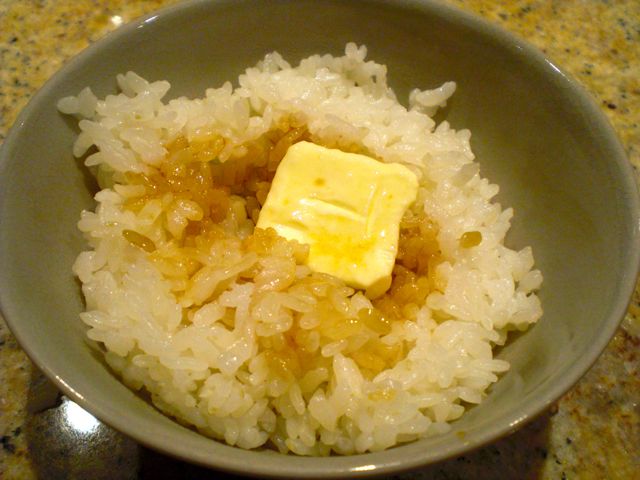
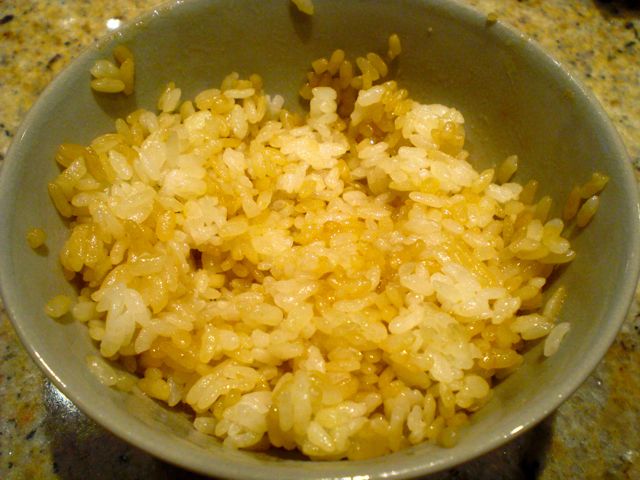
I thought this was a fairly common way for Japanese (especially kids) to eat white rice but apparently that is not the case. This appears to be peculiar to Hokkaido. I guess that makes sense since dairy and specifically butter production are primary industries in Hokkaido.
Monday, November 15, 2010
Japanese-style chicken curry 日本風チキンカレー
"Curry and rice" or "Kareraisu" カレーライス (or sometimes called "Raisukare" ライスカレー) has been an extremely popular "national" dish in Japan for some time. I assume curry was introduced in the late 19th century to Japan by the British, who brought it from their colonial India. I thought Japanese curry was based on the British version made with brown roux and premixed curry powder. There is one more interesting (at least for me) factoid concerning "Kareraisu". It has to do with Dr. William Smith Clark. He was an American from Massachusetts who came to Japan at the bequest of the Japanese Government to establish the Sapporo Agricultural College 札幌農学校, the predecessor of my alma mater Hokkaido University 北海道大学. He served as president of the college albeit briefly (for 8 months). Despite his short tenure, he had an enormous influence on his young Japanese students, Japanese society and particularly Hokkaido. He is credited with introducing New England style modern dairy agriculture to Hokkaido. Reportedly, he also came up with the idea of putting potatoes in curry. He was said to have discouraged the consumption of rice by his students at the school dormitory (he must have thought white rice was causing vitamin B1 deficiency or beriberi.) The one exception to his interdiction against white rice was when it was served as "Kareraisu". He apparently really liked curry and rice.
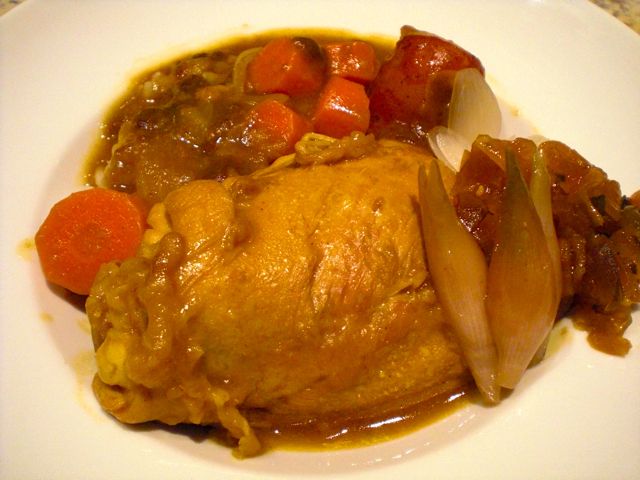
In any case, going back to curry, even when I was living in Japan, some more authentic Indian curry restaurants were opening up. Now, in many cities in Japan, you have many authentic (I suppose) and diverse ethnic curry restaurants. But the Japanese style curry is still popular in Japan and it will not disappear any time soon (I hope). As a sign of the popularity of Japanese curry, commercial Japanese curry roux is even available in a regular American supermarket. I occasionally make my own curry sauce based on brown roux and a Japanese curry powder (supplemented by other spices such as toasted mustard seeds, cinnamon, cumin etc), but the problem is the smell of the spices while being dry roasted linger in the house for several days. So this time, I made this curry using a S&B brand curry roux. My only modification to this Japanese curry is using whole bone-in, skin-less chicken thighs instead of small pieces of meat which is common in Japanese curry. The vegetables to be used include onion, carrot and, of course, potato to be authentic Japanese curry.
Dr. Clark's parting words to the students who came to see him off at a place known as "Hitsujigaoka" 羊ヶ丘 or "Sheep hill" in Sapporo was "Boys, Be ambitious". This became the motto for Hokkaido University as well as general encouragement for young boys in Japan. (The entire phrase was "Boys, Be ambitious like this old man". Thankfully the egotism "like this old man" was left off the Hokkaido University motto). His statue on the campus used to be a major tourist's attraction but is less so now that access is restricted to foot traffic. His statue on the famous Sheep Hill is more easily accessible and more popular. On one of our first trips after our marriage to Hokkaido, I took my bride for a reverent visit to the statue at Sheep Hill. She was significantly underwhelmed. She took one look at the statue with its motto and said "only Boys...really?" She then scanned the pasture with its few obligatory sheep scattered about in keeping with hill's name and dubbed the place "that tourist attraction where they keep a few sheep on leashes." (I sure can digress!)
First, I removed skin and excess fat from the thighs. I dredged them in a mixture of curry powder (again S&B) and AP flour (the proportion is arbitrary but I used 1 tsp of curry powder to 1/4 cup of flour) in a Ziploc bag. I brown the surface of the meat in a large saute pan on high heat with olive oil, turning once for 5 or so minutes per side. I removed the chicken and placed it in a separate stock pot or Dutch oven. I added roughly chopped onion to the saute pan and sauteed for several minutes and de-grazed using a small amount of chicken broth. I added this to the pot with the chicken thighs and added chicken broth (my usual Swanson reduced salt no-fat kind) and water (about half and half to prevent it from being too salty) to cover. I added potatoes (I used small red potatoes with the skin on, eyes removed) and carrot. (The amounts of vegetable and liquid are arbitrary but please refer to the package instructions of the curry roux for the appropriate ratio of the roux and liquid.) I simmered it for 30 minutes with two bay leaves (optional). I dissolved the curry roux and simmered for another 5 minutes.
The classic Japanese condiments to curry are pickled "rakkyou" らっきょう (left) and "fukushinzuke" 福神漬け (right in the back). I had the last of the homemade pickled myouga 茗荷, which was added as well (middle).
Using bone-in whole thighs is easier than cutting up the chicken in small pieces. It also appears to add more flavor to the dish. One of the problems of using the commercial curry roux may be the amount of saturated fat and salt it contains but it tastes really good nonetheless. A good sturdy red wine will be our choice of libation here. We had Worthy 2006 which went well with curry.
Sunday, November 14, 2010
Duck "Nanban" Soba 鴨南蛮
When I made the Japanese-style chicken escabeche, which is called "Nanban" 南蛮 or Southern Barbarian, I mentioned another totally unrelated soba noodle and duck dish called "Kamo Nanban" 鴨南蛮. Since I had leftover roasted duck breast after I served duck breast with orange marmalade sauce one weekend, I decided to make an abbreviated version of "Kamo nanban" on a following weekday evening.

As I mentioned before, Japanese think "duck" and "negi scallion" are the ultimate culinary paring and this dish is usually made of grilled and charred, Japanese or Tokyo scallion or "naga negi" 長葱 in addition to duck meat.
We also enjoyed stewed "Kabocha" squash. As before this one was sold as "Butter cup" squash but I believe this is identical to a Japanese "Kabocha".
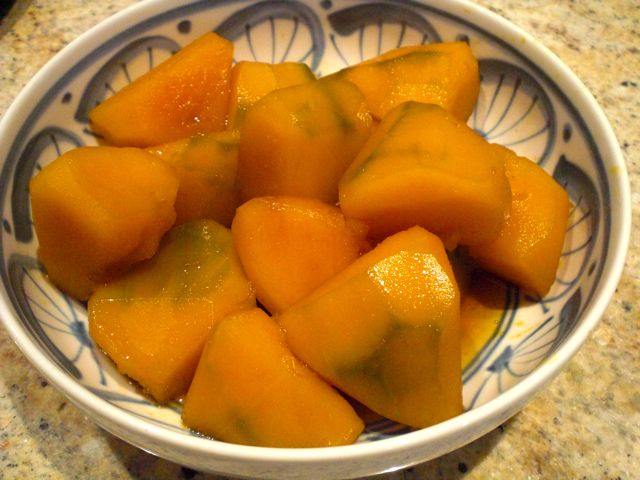
Negi Scallion: Since I did not have a Japanese "Negi" scallion, I used a wedge of onion. I cooked it slowly in a frying pan with a bit of light olive oil, turning over once or twice for 10 minutes or until nice char marks developed on both sides and the onion is cooked.
Broth: I used one "dashi pack (The one I used had kelp and dried bonito, but no dried fish)" in water (about 1.5 cups) and simmered for 5 minutes to make dashi. Any dashi, including instant granulated ones, will do. I added mirin (1tbs) and soy sauce (2 tbs to taste, I could have added more in retrospect). I kept it just barely simmering or hot.
Duck breast: The leftover duck breast had nicely browned skin and was cooked to medium rare. I cut thinly (1/4 inch) and then dusted the pieces with potato starch, katakuriko 片栗粉. I placed each piece in the simmering broth (above) for 20-30 seconds so that the starch cooks into a slightly slippery coating on the surface of the meat. It also very slightly thickens the broth. if I was cooking the duck from scratch, I would cook the skin side only in a frying pan rendering as much fat as possible while making the skin brown following the first step of my usual way of cooking the duck breast. Instead of finishing the duck in the oven, I would slice the meat and cook it in the broth as descried above for a slightly longer time. You can omit the potato starch, if you do not like the slippery texture.
Soba noodle: I just used dried soba and cooked as per the package instruction, washed in running water, drained and placed in the center of an individual serving bowl.
Assembly: In the bowl with soba noodle on the bottom, I added the broth, and arranged the onion and duck meat as seen above. I garnished it with chopped green onion. Just before eating, I sprinkled 7 flavored Japanese red pepper powder 七味唐辛子.
Up until this point, we were enjoying Orin-Swift "The Prisoner" 2009 (Zin and Cab mix). It was certainly a good wine but it is not as good as the prior vintages and we prefer "Papillon" 2007 (Bordeaux blend with predominant Cab) from the same winery. But this dish cries out for sake and we obliged. I should have added a bit more soy sauce to the broth but otherwise it was a very nice dish and indeed went very well with cold sake.
We also enjoyed stewed "Kabocha" squash. As before this one was sold as "Butter cup" squash but I believe this is identical to a Japanese "Kabocha".
Friday, November 12, 2010
Mac and Cheese マカロニチーズ
I think that the quality and types of cheeses are most important. My recipe is nothing unusual. I first make béchamel sauce and add cheeses, combined with cooked elbow macaroni and bake. This recipe is for about 6 oz of macaroni, which makes about 4 small servings. We cooked one box (16 oz) of elbow macaroni and we used about 2/3 for macaroni salad and 1/3 for Mac and cheese.
Macaroni: As per the instruction on the package, cook Macaroni (al dente, since this will be further baked). I season it with salt and pepper in a colander immediately after draining and coat it with a small amount of olive oil. The macaroni alone at this stage should be well seasoned and taste fairly good.
Sauce: I first make béchamel. I finely chop shallot (one medium or 1/2 large), and saute in olive oil (3 tbs) and butter (1/2 tbs) and add flour (3 tbs). Cook flour for 1-2 minutes (do not brown, we are not making brow roux) and add about 2 cups of milk (I used 1%) at once and whisk to resolve and keep stirring until it thickens. Add more milk depending on the consistency of the sauce. I keep this rather loose since the addition of the cheeses makes the sauce thick. I season it with salt, pepper, and freshly grated nutmeg. Using freshly grated nutmeg makes a big difference in taste.
I poured the sauce into the cooked macaroni and mixed in shredded cheddar (1/2 cup, I used aged sharp cheddar). I tasted the mixture and adjusted the seasoning. I apportioned the mixture into 4 small individual ramekins. I grated Parmigiano reggiano cheese on the top. You could use bread crumbs on the top as well, but I did not. I baked it in a 400F (toaster) oven for 7-10 minutes or until the surface browns and the sauce is bubbling.
This was not bad (my wife's opinion was much less reserved but, then again, she may be biased). Nonetheless, to me, the sauce was a bit too grainy and I blame it on the goat cheese. Next time I will have to be more moderate in using it. In any case, this was far better than Kraft's or Wolfgang Puck's mac and cheese. This dish goes well with wines and beer (although we drink beer extremely rarely). I would suggest Izakaya in Japan consider serving this. It may become a big hit.
P.S. We had this later in the week as leftovers reheated in the toaster oven. Strangely enough, the taste and texture were much better and the graininess of the sauce disappeared.
Wednesday, November 10, 2010
Chicken breast cutlet 鶏胸肉のカツレツ
It is a somewhat mundane dish but a nice dish to start. We had this with a red wine but I can not remember which one this was.
Monday, November 8, 2010
Poached egg, smoked salmon with crème fraîche ポーチドエッグとスモークサーモン
This can be a breakfast (for us) on weekends when it strikes our fancy or a mid-night snack after drinking (for younger fellow imbibers). I'm not sure how this got started but my wife came up with this one. It is a cross between bagels, lox and creme cheese (hold the bagel) and a variation of eggs benedict (hold the hollandaise). This variation may be (very) slightly, less deadly than the original because there is no hollandaise sauce and (hopefully) some benefit from the Omega 3 in the salmon.

The poached egg should have a runny egg yolk so that when you cut into it, the yolk makes a wonderful sauce. The combination of all these ingredients work so well together. If you like smoked salmon, you will like this dish.
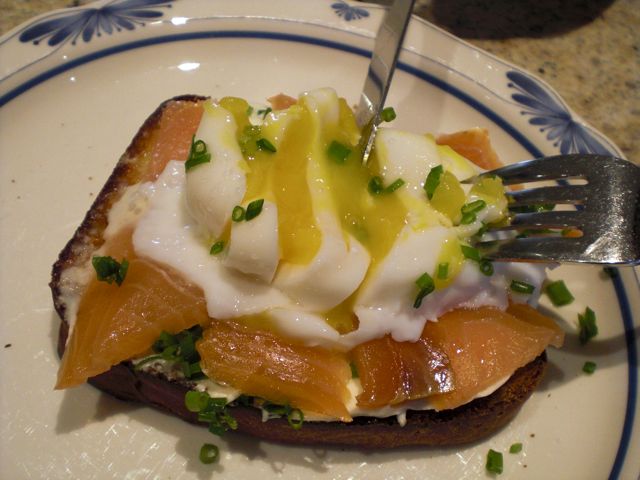
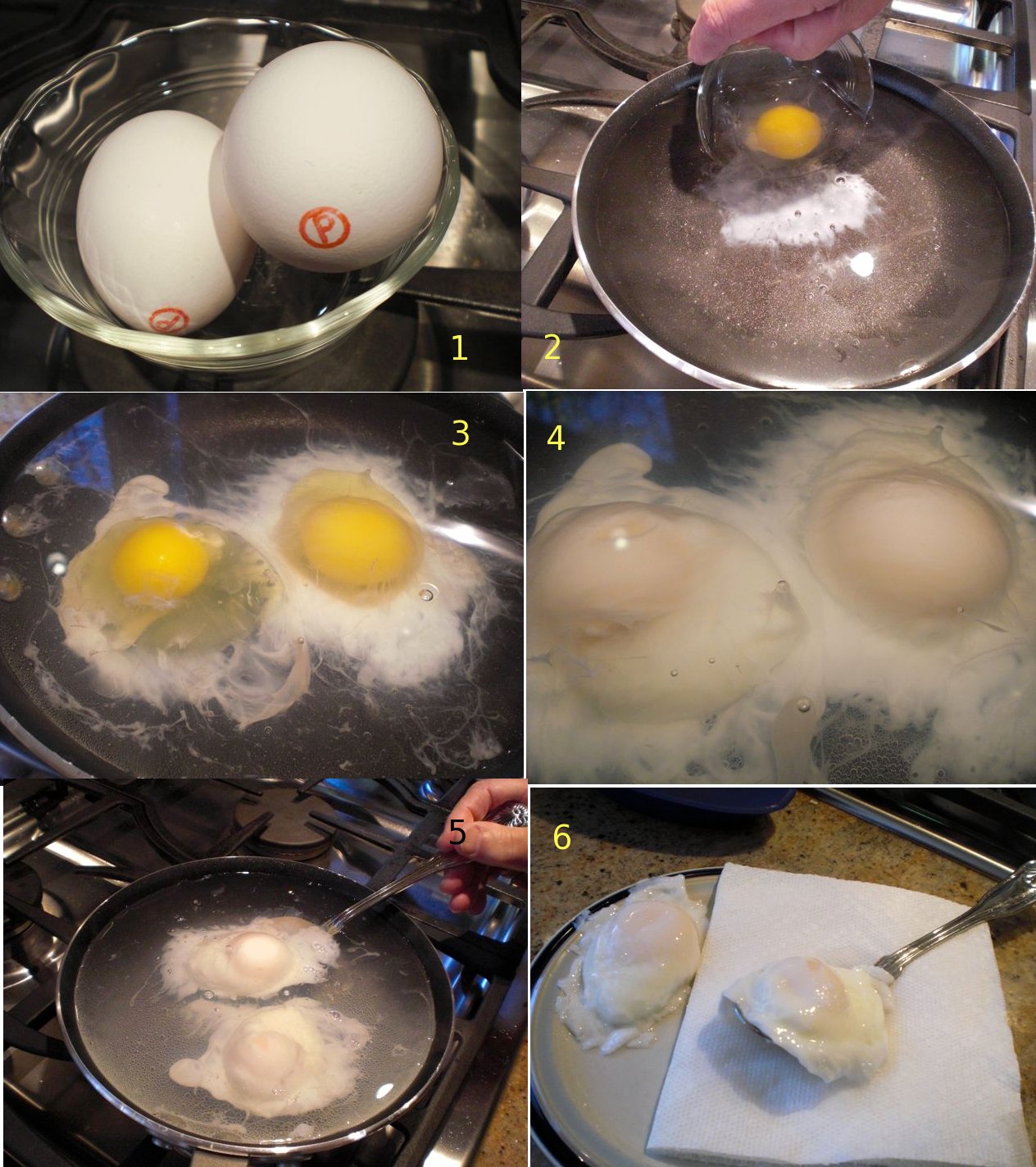 5. Using a perforated (slotted) spoon, gently separate the eggs from the bottom. It should not be difficult if the pan is a good non-stick pan. If you encounter undue difficulty, use a silicon spatula to separate the eggs from the bottom of the pan, (if that happens you may want to throw out the pan and buy a new one).
5. Using a perforated (slotted) spoon, gently separate the eggs from the bottom. It should not be difficult if the pan is a good non-stick pan. If you encounter undue difficulty, use a silicon spatula to separate the eggs from the bottom of the pan, (if that happens you may want to throw out the pan and buy a new one).
If you are into the looks, you could take off thin peripheral shaggy portions of the egg white to make it pretty.
The recipe starts with a base of toasted and buttered English muffin bread (homemade, my wife promised me to post her recipe soon). On top of that goes a generous smear of crème fraîche (if not available, use sour cream or cream cheese). Next comes a sprinkle of chopped chives (my wife puts the chives on at this point so they are held in place by the next layers. Otherwise they just fall off the piece on the way to your mouth. One layer of good cold smoked salmon follows the chives and the whole thing is topped with a poached egg. We sprinkled salt on top of the egg and more chopped chives as garnish. (It doesn't matter if these fall off the chive flavor is locked in the lower layer.)
Since I mentioned several times how easy it is to make poached eggs but never really illustrated the steps, I decided to post some visual aids. We tried many methods including an egg poacher, a classic vinegar water method, Pepin's swirl-water-and-put-an-egg-in-the center-of-the-vortex method (it appears he is not advocating this silly method any longer) but our method always works, no fuss no muss.
1. Use pasteurized eggs (in the U.S., notice a red "P" in a circle).
2. Use a good non-stick frying pan with a high side wall and add enough water so that the eggs can be completely submerged. I also salt the water for subtle seasoning of the eggs (optional) but absolutely no vinegar. (We do not like vinegar tasting eggs). The water should be just barely simmering. Crack an egg into a small ramekin and slide the egg as seen here.
3. Eggs will sink to the bottom.
4. Eggs will stick to the bottom (Do not worry). Poach them until the surface of the yolks are opaque and set but the yolks are still runny (4-5 minutes).
6. Drain the water trapped by the spoon or dripping off the egg by touching the bottom of the perforated spoon to a paper towel and place it on the plate (Do not leave it on the paper towel. It will become very difficult to transfer without breaking the yolk). I usually keep one on the spoon as seen in the picture for easy transfer.
If you are into the looks, you could take off thin peripheral shaggy portions of the egg white to make it pretty.
Saturday, November 6, 2010
Julienned potatoes with spicy cod roe redux ジャガイモの明太子和え 再登場 (Mark's book p24)
We liked the nori taste with tarako and potatoes. Either way (the original or this version), this is an excellent dish. We really like both versions.
Subscribe to:
Comments (Atom)



